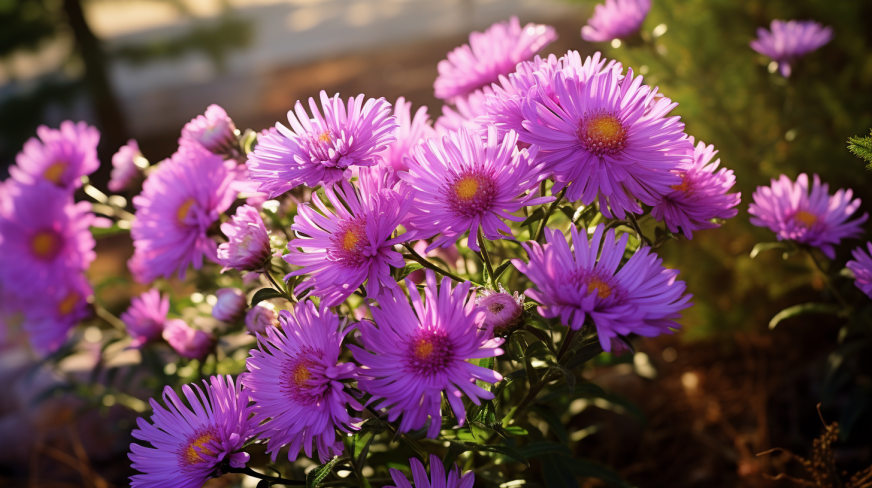Aster Flowers

Aster flowers have long charmed gardeners and flower enthusiasts with their vibrant daisy-like blossoms. Native to various parts of the world, these hardy perennials are particularly popular for their late-season blooms, often providing colour when many other plants have finished flowering. However, understanding the nuances of their planting and care is crucial to capturing the beauty of these flowers. Proper cultivation techniques can lead to healthier plants and more abundant blooms, making your garden a standout in any neighbourhood.
How to Plant Aster Flowers

Choosing the Right Spot
- Importance of Sunlight: For most Aster varieties, full sun is essential. These flowers thrive with at least 6-8 hours of direct sunlight daily. Adequate sun exposure boosts flower production and strengthens the plants against diseases.
- Soil Preference: Asters are relatively adaptable but prefer well-draining soil. A slightly acidic to neutral pH range (6.0 to 7.5) is optimal. If you’re unsure about your soil’s pH, a simple test kit from a garden centre can provide clarity.
Preparing the Soil
Testing and Amending the Soil
Begin by testing the soil to determine its pH and nutrient levels. If soil is too acidic or alkaline, amending it with lime or sulphur can bring it to the desired pH range. Adding compost or organic matter can also enrich the soil, making it more conducive for Aster growth.
Proper Drainage and Aeration
Ensure that the chosen spot drains well to prevent root rot. If planting in a garden bed, elevate the bed slightly or mix in some coarse sand to improve drainage. Aeration can be enhanced by turning the soil using a garden fork.
Planting Steps
When to Plant Aster Seeds or Seedlings
The ideal time for planting Aster seeds is spring after the last frost. If starting with seedlings or young plants, late spring to early summer is preferable, giving them ample time to establish before winter.
Spacing Recommendations
Space Aster plants about 1 to 3 feet apart, depending on the variety. This ensures adequate air circulation, which can mitigate potential disease outbreaks.
How to Grow Aster Flowers
Frequency and Amount of Watering
Asters prefer consistently moist soil but not soggy conditions. In the growing season, water them deeply once a week. However, adjust based on rainfall and soil moisture levels.
Over-watering and Under-watering Symptoms
Overwatered Asters may exhibit yellowing leaves and a saggy appearance. Under-watered plants might have droopy leaves and reduced bloom sizes. Always check soil moisture before watering.
Fertilization
Best Types of Fertilizers for Asters
When nurturing aster, selecting the correct type of fertilizer is crucial for ensuring healthy growth and vibrant blooms. A balanced, slow-release fertilizer is often the best choice for these flowers. A formula with an equal ratio of critical nutrients, such as a 10-10-10 blend, provides a well-rounded supply of nitrogen, phosphorus, and potassium. This fertilizer ensures that Asters receive a consistent supply of essential nutrients over time, promoting steady growth without the risk of nutrient burn or rapid spurts that can occur with more concentrated formulas.
In addition to synthetic fertilizers, Asters also respond well to organic options. Using compost or well-decomposed manure offers a multitude of benefits. These natural fertilizers supply essential nutrients, improve soil structure and encourage beneficial microbial activity. This can lead to better root development and improved overall plant health. Compost, in particular, acts as a gentle, slow-release fertilizer, making it an excellent choice for gardeners who prefer organic gardening. On the other hand, well-decomposed manure is rich in nutrients and can help maintain soil fertility over time. However, ensuring the waste is fully decomposed is essential to avoid any potential plant harm.
Timing and Frequency of Application
The timing and frequency of fertilizer application play a pivotal role in the health and flowering of Asters. The first application should be made in early spring, just as the plants begin to show new growth. This initial feeding provides the necessary nutrients to kickstart the growing season, supporting the development of strong stems and lush foliage. It’s essential to apply the fertilizer evenly and follow the recommended rates on the product label to avoid over-fertilization, which can harm plant health.
As the growing season progresses, a second fertiliser application in mid-summer can be highly beneficial. This mid-season feeding is essential for supporting the blooming phase of Asters. By replenishing nutrients at this crucial stage, gardeners can ensure their Asters have the necessary resources to produce abundant and vibrant flowers. It’s important to note that over-fertilization during this period can lead to excessive foliage growth at the expense of flowers, so moderation is key. Additionally, it’s advisable to water the plants thoroughly after applying fertilizer to help dissolve the nutrients and make them readily available to the roots.
In summary, a combination of proper fertilizer selection and strategic application timing can significantly enhance the growth and flowering of Asters, resulting in a beautiful and healthy display in the garden.
Dealing with Pests and Diseases
Common Pests that Affect Aster Flowers
Aster flowers, with their vibrant colours and varied forms, are susceptible to several common pests that can significantly impact their health and appearance. Among these, aphids, leafhoppers, and slugs are the most prevalent.
- Aphids, small sap-sucking insects, can quickly colonize the stems and undersides of leaves, causing damage and potentially spreading diseases.
- Leafhoppers , another group of sap-sucking pests, are known for their ability to jump and fly, making them somewhat challenging to control. They can cause a stippling effect on the leaves as they feed.
- Slugs , particularly problematic in moist and shady gardens, are known for their voracious appetite for the leaves of many plants, including asters.
Regular inspection of aster plants is crucial in identifying these pests early on. Early detection is critical to effective management, as large infestations can be more challenging to control and cause significant plant damage.
Prevention and Treatment Options
Gardeners have several options to manage the common pests affecting aster flowers effectively.
For aphids and leafhoppers, insecticidal soaps or neem oil treatments are effective. These solutions work by suffocating or disrupting the life cycle of these insects, and they are generally considered safe for the garden environment when used as directed. Neem oil, in particular, has the added benefit of being a natural product that is less harmful to beneficial insects.
For slug control, diatomaceous earth can be a helpful deterrent. This natural product causes physical damage to the slugs as they crawl over it, leading to dehydration and death. Alternatively, slug traps, which often use beer as bait, can effectively reduce slug populations by attracting and trapping them.
Alongside these direct treatment options, preventing fungal diseases is crucial in maintaining healthy aster plants. This can be achieved through adequate plant spacing to ensure good air circulation, regular pruning to remove dead or diseased foliage, and fungicides if necessary. These fungicides should be used as a last resort and by their labels, as overuse can lead to resistance or harm to non-target organisms.
Combining these preventive and treatment strategies can help maintain healthy aster plants free from pests and diseases.
How to Care for Aster Flowers
Pruning and Deadheading
Pruning aster flowers is a vital gardening practice that yields multiple benefits, significantly enhancing the plant’s health and aesthetic appeal.
One of the primary advantages of pruning is promoting a bushier growth habit. When asters are pruned, the plant grows more lateral branches, leading to a fuller and more robust appearance. This bushier growth makes the plant more visually appealing and can help support more blooms.
Speaking of colours, another significant benefit of pruning is encouraging more flower production. Removing old and spent blooms stimulates the plant to produce new flowers, leading to a more extended blooming period. This can be particularly beneficial for gardeners who wish to enjoy vibrant aster blooms for as long as possible.
Additionally, pruning plays a crucial role in the health of the aster plant. Pruning helps prevent the spread of diseases and pests by removing the plant’s diseased, damaged, or dead portions. This also promotes better air circulation within the plant, which is crucial for maintaining plant health.
When and How to Prune Aster Flowers
The ideal time for pruning these plants is typically in late winter or early spring. This timing is strategic because it prepares the plant for a new growth cycle and ensures that it is not burdened by old growth as it enters the growing season.
The primary method for pruning asters during this period involves cutting the old stems to ground level. This may seem drastic, but it is a highly effective way to rejuvenate the plant. Removing these old stems allows the plant to produce new, healthy growth essential for vigorous blooming in the upcoming season.
In addition to this annual pruning, regular maintenance throughout the blooming season is also necessary. This includes the practice of deadheading, which is the removal of spent flowers.
Deadheading should be done regularly and is a simple yet effective way to encourage the Aster to continue producing blooms. Removing these old flowers stimulates the plant to create new ones, extending the blooming period and keeping the plant looking fresh and vibrant.
Winter Care
Preparing Asters for Colder Months
As winter approaches, reduce watering and let the plant die back naturally. This process helps the Aster store energy for the next growing season.
Mulching and Protection Techniques
Apply a thick layer of mulch around the base of the plant. This protects the roots from freezing temperatures and retains soil moisture.
Propagation Techniques
How to Propagate from Seeds
Collect seeds from mature flower heads and sow them in seed trays with a quality seed mix. Once seedlings are large enough to handle, transplant them to their final location.
Dividing Established Plants
Every 2-3 years, in early spring or fall, divide mature Aster clumps to rejuvenate the plant and create new ones. Ensure each division has a good amount of roots and shoots.
Conclusion

Cultivating aster flowers in your garden is a rewarding experience, filled with vibrant colours and lively blooms that can brighten any space. With the correct planting techniques, regular care, and proper pruning, you can ensure that these charming flowers thrive and bring beauty to your outdoor or indoor spaces.
At Bourkes Florist , we offer a stunning selection of flower arrangements perfect for any occasion. Whether you’re celebrating a special event, expressing gratitude, or simply bringing a touch of nature’s beauty into your home, we got you covered! Place your order today and brighten someone’s day.
FAQs
Q: When is the best time to plant Aster flowers?
The best time to plant Aster seeds is after the last spring frost. For seedlings or young plants, late spring to early summer is ideal.
Q: How often should I water my Asters during peak summer?
Typically, water Asters deeply once a week, but adjust based on rainfall and soil moisture.
Q: Are Asters deer-resistant?
While Asters aren’t the top choice for deer, hungry deer might still nibble on them. It’s best to use deterrents if deer are prevalent in your area.
Q: Can I grow Asters in pots or containers?
Asters can be grown in pots, but ensure the container has good drainage and is spacious enough for root growth.
Q: How tall do Aster plants typically grow?
Depending on the variety, aster can range from 8 inches to 8 feet in height. Always check the specific growth habits of the type you’re planting.

























